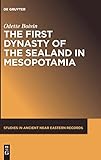The First Dynasty of the Sealand in Mesopotamia / Odette Boivin.
Material type: TextSeries: Studies in Ancient Near Eastern Records (SANER) ; 20Publisher: Berlin ; Boston : De Gruyter, [2018]Copyright date: ©2018Description: 1 online resource (XV, 292 p.)Content type:
TextSeries: Studies in Ancient Near Eastern Records (SANER) ; 20Publisher: Berlin ; Boston : De Gruyter, [2018]Copyright date: ©2018Description: 1 online resource (XV, 292 p.)Content type: - 9781501516399
- 9781501507861
- 9781501507823
- 935/.02 23
- DS73.3 .B65 2018
- online - DeGruyter
- Issued also in print.
| Item type | Current library | Call number | URL | Status | Notes | Barcode | |
|---|---|---|---|---|---|---|---|
 eBook
eBook
|
Biblioteca "Angelicum" Pont. Univ. S.Tommaso d'Aquino Nuvola online | online - DeGruyter (Browse shelf(Opens below)) | Online access | Not for loan (Accesso limitato) | Accesso per gli utenti autorizzati / Access for authorized users | (dgr)9781501507823 |
Frontmatter -- Preface -- Contents -- Tables and Figures -- Conventions and Abbreviations -- 1. Introduction -- 2. The Sealand I in Babylonian historiography -- 3. Geographical and chronological considerations -- 4. A political history of the Sealand kingdom -- 5. The Sealand I palatial economy -- 6. The Sealand I panthea and religious history -- 7. Conclusion -- Appendix 1: BKL A and Babylon I-Sealand I synchronism -- Appendix 2: Sealand I year names -- Appendix 3: Text numbers corresponding to Table -- Bibliography -- Indexes
restricted access online access with authorization star
http://purl.org/coar/access_right/c_16ec
The Sealand kingdom arose from the rebellion against Babylonian hegemony in the latter half of the 18th century BCE., forcing it to share power over Sumer and Akkad. Although its kings maintained themselves throughout the turmoil leading to the demise of the Amorite dynasty at Babylon, it remains one of the most poorly documented Mesopotamian polities. Until recently, it was known to us mainly through its inclusion into later king lists and chronicles, but the recent publication of well over 400 archival texts from a Sealand palace, soon followed by literary and divinatory tablets, finally makes it possible to study this polity from primary sources. This book proposes a history of the Sealand kingdom based on the new evidence and a reevaluation of previously known sources. The aspects examined are: the economy — mainly the palatial administration and transformation of agricultural and animal resources; the panthea and the palace-sponsored cult, which show that Sealand I kings may have positioned their rule in a Larsean tradition; the political history, including a discussion of the geography and the relative chronology; the recording and transmission of knowledge on the Sealand I dynasty in Mesopotamian historiography.
Issued also in print.
Mode of access: Internet via World Wide Web.
In English.
Description based on online resource; title from PDF title page (publisher's Web site, viewed 28. Feb 2023)


